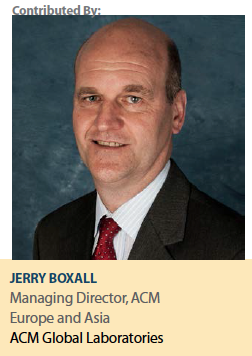Central laboratories — charged with providing harmonized clinical diagnostic testing and a consolidated database for clinical  trial sponsors — continue to evolve against the backdrop of an increasingly complex clinical trial environment. Today the industry balances the demands of complicated laboratory testing requirements, budget restrictions, and geographical challenges while maintaining a constant focus on the deliverables sponsors require.
trial sponsors — continue to evolve against the backdrop of an increasingly complex clinical trial environment. Today the industry balances the demands of complicated laboratory testing requirements, budget restrictions, and geographical challenges while maintaining a constant focus on the deliverables sponsors require.
The modern central lab is a series of harmonized global laboratories using state-of-the-art instrumentation, identical analytical platforms and reagents, and staffed with personnel adhering to universal standards of practice. As clinical trials become increasingly reliant on a broad global array of study sites, sponsors also rely on central labs to spearhead the logistics of these often widespread locations, leaning on their expertise, experience, and scale.
With the experience and knowledge of three decades, the central lab industry has evolved in a number of directions due to several influencing factors, including global trial requirements, analytical complexity, and broad testing requirements. At the core of the many sponsor requirements is global consistency of service, with central labs required to provide validated, consistent, and dependable test results regardless of whether the sample was collected in Singapore or  Rochester, New York.
Rochester, New York.
The Establishment of Central Labs
The central laboratory concept got its start in the mid-1980s in response to shifts in clinical trial management and needs. Prior to the transition, most diagnostic testing supporting clinical trials was conducted in local laboratories, with a focus on evaluation of patient safety. At that time, clinical diagnostic testing for efficacy was often a secondary consideration.
Sponsors became less reliant on local laboratories as the central lab’s ability to streamline clinical trial diagnostic testing and consolidate test results came into view. The necessity of central labs grew, in part, of a need to efficiently and accurately process high volumes of specimens as clinical trials grew larger and more global in scope. Central laboratory service providers turned their attention to standardizing collection kits and consolidating laboratory results into a single database, thereby, enhancing consistency and reducing costs.
Considering how different central labs look today when compared with the industry’s beginnings, the pace of change has been surprisingly slow. But that was out of necessity, as regulatory agencies govern many change pathways with their patient safety requirements and secondarily, oversee data and study integrity. Central labs must strike a delicate balance of meeting trial sponsors’ growing demands while upholding regulatory standards and requirements.
The Inherent Challenges of Global Expansion
The globalization of clinical trials has elevated the central lab business to new levels, but has also introduced an array of new challenges. For years, central labs persevered as markets around the world — from South America to India and China — emerged one after another. The introduction of new regions means keeping up with permits, regulations and other requirements unique to each country. To ensure success in new corners of the world, providers must develop an understanding of the infrastructure and logistical challenges each presents.
The global scope of clinical trials has forever changed the business. Studies today are increasingly larger, with more investigator sites spread across more countries. Nearly all major regions of the globe have emerged as part of the clinical trial fabric. Due to global expansion, laboratories are challenged to maintain standards in a variety of settings and stay on top of regulatory requirements. To establish operations in numerous unfamiliar markets, central labs need to do their homework and always be prepared with a backup plan.
Having a global presence introduces a long list of potential challenges, ranging from specimen transport and customs requirements to import/export restrictions and political instability. It’s just as important to plan around the height of winter when shipping specimens from Siberia as it is to have a back-up plan in an area with an unpredictable regulatory environment.
Developing effective solutions to these challenges is critical to maintaining consistency in testing and achieving the desired results.
Industry Marches Toward Personalized Medicine
Over the last two decades, the mainstay of central labs’ functionality has shifted alongside the rapid progression of diagnostics and the expansion of available efficacy markers. In a clinical trial, the lab’s principle focus is the same from the onset to the deliverable at the end: demonstrating the safety and efficacy of an investigative medicine.
As some areas of drug development become more targeted, central labs have an opportunity to expand their repertoire well beyond safety and efficacy measures to embrace specific assays that include the genomic profiles of patients and patient populations. Although the development of personalized medicine and the corresponding diagnostic tests are still in the relatively early stages of development, central labs have kept pace with innovation by offering a more sophisticated array of tests, including genomic testing on a large scale. Down the line, the adoption of next-generation sequencing holds the potential of driving down costs and opening up new opportunities for clinical trial testing.
Regulatory oversight aside, the industry’s pace of change has been accelerated by recent trends in digital data, communication, and global accessibility. With technological advancements, each of these components enables constituents—both local and global—to quickly communicate and engage. And with expertise spanning every therapeutic area in clinical development, the central lab model requires a seamless interaction between laboratories, investigator sites, and logistical support personnel.
Early Engagement Positions Clinical Trials for Success
Another newly introduced focus — one that continues to evolve — is engaging trial sponsors early-on in the clinical trial process to optimize the information gained by the diagnostic testing elements. Early engagement helps guide sponsors in selecting the most cogent, patient- and physician-friendly, and cost-effective tests for a given trial protocol. Although service providers stress the importance of conducting a laboratory review early in the protocol development process, adoption of this approach remains a work in progress. Many sponsors continue to think of diagnostic testing as a supporting or secondary consideration when fielding a trial, posing a challenge for central laboratories.
With an early engagement approach, central labs can keep sponsors apprised of rapidly improved and increasingly more complex diagnostic testing options. It’s often difficult for sponsors to keep up with the changes themselves, however, central labs are entrenched in clinical diagnostic testing with a deep knowledge of each test’s intricacies. With early engagement, critical milestones are aligned with time and cost restrictions, and resources can be applied optimally without increasing the level of risk.
This approach is critical as central labs generate 60% to 70% of the data submitted within a product’s registration filings with regulatory agencies. Central labs can work directly with sponsors to streamline the process and collect data beginning with the trial’s inception. ACM Global Central Laboratory’s Smarter Testing approach, for example, encourages sponsors to collaborate with the central lab’s scientific experts to discuss study outcomes, identify endpoints to support those outcomes, and finally select the tests that will provide endpoint data.
With today’s advanced menu of central lab offerings, a more thoughtful test selection process is required. The Smarter Testing approach carves out a true partnership between the central laboratory and the trial’s sponsor, one that adds value and helps accelerate the path from molecule to clinic.
The Central Lab of the Future
As the global market for clinical trials continues to grow and diversify, central labs are tasked with keeping pace with ongoing change. A few areas are expected to witness change and alter the central laboratory industry in the foreseeable future, including:
Precision Medicine: Clinical trials will see an increased focus on molecular genetics and matching diagnostics to specific genotypes and disease subtypes as the blockbuster drug model proves to be challenging to sustain. New types of testing, specific biomarkers, and companion diagnostics will play a role in the central lab’s support of highly targeted therapeutics and precision medicine.
Diagnostic/Localized Testing: With continued improvements to the technology driving point-of-care testing, central labs will need to combine the rapid response and diagnosis offered by those tests with its own ability to find and measure disease in minute and early stages. The result will be greater speed and diagnostic certainty for specific patients and their current clinical state.
Integrated Diagnostics: An advanced clinical trial diagnostics model integrates central lab diagnostics with other centrally based testing, such as centralized imaging and centralized cardiac diagnostics. Supported by advances in the management of data streams across various diagnostic domains, this model offers the potential for rapid evaluation of a patient’s total clinical state. In turn, this approach allows for rapid analysis of the safety and efficacy impact of the medicine being tested, and early identification of potential issues and/or trends, at both the individual patient and population levels.
Data Analysis: Using data to improve processes is trending in the central lab universe. By leveraging the large volume of diagnostic data they generate, central labs can effectively data mine their information for therapeutic trends, expected outcomes, and trial efficiencies based on in-depth analytics.
In its 30 years, the central lab industry has gone global, adopted more complex testing approaches and widely expanded its clinical trial offerings. As the industry has stretched its competencies with the times, central lab service providers have remained true to their core values: trustworthiness, precision and accuracy.
The industry continues to respond to the changing demands of the clinical trial environment as it balances data integration, software, and operational challenges driven by complexity and broad global scope. These challenges demand that central labs continue to harmonize their processes for consistency, cost-effectiveness, and reliability while adhering to industry and regulatory standards and demonstrating the quality of their services with the required accreditations and certifications.
Today, central labs provide clinical trial services for virtually all of the well-known biopharmaceutical companies and contract research organizations that dot the globe. Changes on the regulatory front will likely continue to unravel slowly, juxtaposed with the fast-paced opportunities and challenges of managing advanced diagnostic technologies and data analytics solutions. (PV)
ACM Global Laboratories specializes in delivering high quality central laboratory testing services designed to optimize clinical trial outcomes. Through a powerful combination of robust global capabilities, operational and scientific expertise and unsurpassed service, ACM Global acts as an extension of our clients’ clinical teams to develop and execute Smarter Testing strategies that deliver reliable outcomes for their clinical development programs. Operating in more than 60 countries, ACM Global’s analytical team performs more than 15 million diagnostic tests each year from a test menu with more than 1,500 tests spanning all medical disciplines, including pathology, microbiology and molecular diagnostics, flow cytometry, specialized biomarkers, and pharmacogenomics.
For more information, visit acmgloballab.com.


















